Every place we go to during our lives is clothed in art and decorations. Whether it is the graffiti sprayed on the side of buildings, a painting of the beach during a sunset hanging on the wall in a doctor?s office, or a sculpture of horse mounted on a front porch, they all fall under the category of art. If we did not care to decorate our environments with art, the scenery we encounter would be dull, colorless, and meaningless. The intangible elements, emotions or beliefs, that make up our existence as human beings and individuals are depicted in artwork. The art and decorations that surround us have the intention to inflict a certain emotion and vibe in the atmosphere.
Recently, I have become a victim of living in a room where art is absent, which I feel has given my room, and essentially my days, a meaningless touch to it. Eager to reconstruct my room into an area that will be relaxing and represent my personal view on life, I have been searching for artworks and decorations that will solve this problem. As I have been walking through home dcor stores and scrolling on the Internet for house decorations to buy, I have come across an immense amount of elephant paintings and sculptures. What I found interesting about this was that these items were not just the figure of the animal. Each of these depictions of elephants were unique in their own way, but at the same time they were similar in the way that they were embellished in jewels and beautified by rich colors like gold and silver. I mentioned this to my friend, who replied with a quick close-minded remark that elephants are hipster. But as a knowledgeable artist who has studied the time line of art, I understand the inevitability of artistic styles and ideas traveling to foreign countries. The elephant just had to be apart of that voyage.
I was driven to do some research to answer the question: why, out of the many diverse animals that exist on this planet, is there a popular demand for elephant objects? The information that I have gathered is vast and profound, but it is important to those who purchase these items because they view them as a decorative piece that is considered hipster. Hidden behind these elephant pieces are distinctive meanings and beliefs that are tied to India?s culture and religions, which these young hipsters may not fully comprehend.
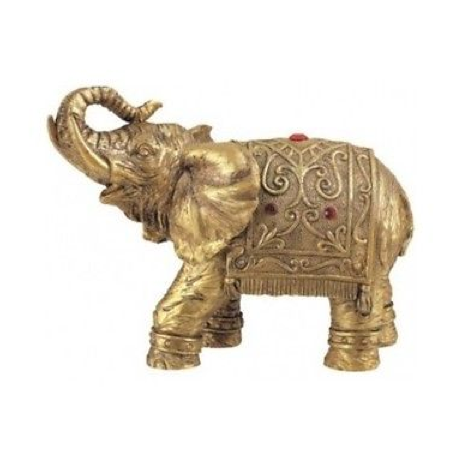
The American culture values that drive art creation differ from the Indian culture inspiration for art. In the book India: Art and Culture, 1300?1900, Stuart Cary Welch explains that the essence of Indian art is the profound spiritually felt throughout the country (22). Spirituality in Indian religions is rooted in the natural environment. It focuses on the intimate connection between nature and the human aspiration. The breath taking nature in India is considered to be associated with mystical forces. Welch describes the geography in India as being a mixture of high peaks, long flourishing valleys, scorched waterless deserts, extremely flat plains, and dense jungles. Although this is picturesque scenery, Welch explains that India experiences extreme opposite weather conditions with ?erratic behavior?. In ancient religions of India this type of weather performance has been considered as being a result of the forces and spirits of nature being personified by the deities (23). This geographic occurrence has shaped India?s culture to recognize the mystical concepts of the world. Recognition of these transcendent concepts is not sufficient enough for one to be connected with the higher being represented in nature; therefore Indian religions stress the importance of spiritual rituals. Welch states that Hinduism and Islam practice highly evolved rituals, sacrifices, and spiritual disciplines. These spiritual disciplines include yoga, pranayama the act of breath control, mantras the idea of words of power, and trance (24). Spiritual practices like these ones are expressive of India?s overall religious techniques that are meant to help people get in touch with their inner consciousness. Welch describes these rituals and techniques as the Indian culture?s way of recognizing all that is ?good? and all that is ?bad?, but focusing on the light of every aspect of the world (24). This emphasis on the physical and mental practice of consciousness awareness is a way of worshiping the deities that control the universe, but what does this have to do with elephants?

Animals are included in the nature category that is considered to be an intangible being of a spiritual force. The idea that animals act as symbols for the divine realm of the universe is practiced by India?s prominent religions, Hinduism and Islam. In Welch?s description of these religions he states that they are divided into many sects and branches. Welch explains that over the centuries these sects and branches have been blended with the eternal bliss and magical beliefs of animists, who were know for worshipping the spirits of trees, rivers, animals, or ancestors. The spiritual practices that Welch described are said to be adapted from animist, who looked to the symbolic aspects of animals for guidance (24). In Dictionary of Symbols J. C. Cirlot explains that the symbolism of animals are based off of three main ideas: the animal as a means of transportation, as an object of sacrifice, and as an inferior form of life (13). One of the many animals that are associated with these three main ideas and are believed to obtain powerful aspects is an elephant. Cirlot also explains, ?Identifying oneself with animals represents integration of the unconscious and sometimes- like immersion in the primal waters- rejuvenation through bathing in the sources of life itself? (13). Elephants act as an emblem due to the animal?s mythical character and strong attributions that are considered to be models for the people in India. Cirlot states, ?Elephant-symbolism is somewhat complex for it embraces certain secondary implications of a mythic character. In the broadest and universal sense, it (elephants) is a symbol of strength and of the power of the libido. Indian tradition has it that elephants are the caryatids of the universe? (96). This brings up the question of how elephants evolved into this mythical and symbolical figure, which can be answered in two categories: physical attributes and spiritual characteristics.
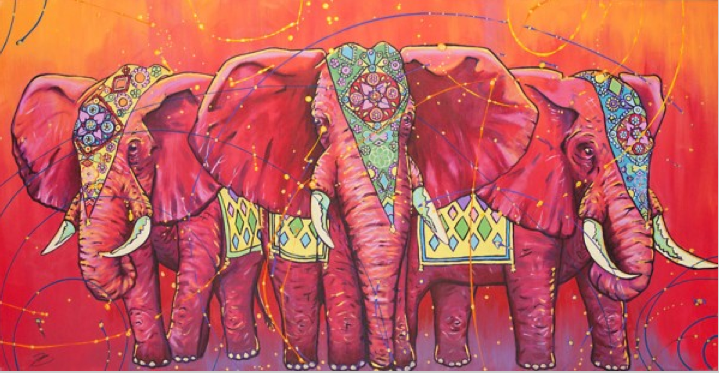
The figure structure of the elephant is recognizable as being strong and hefty, which explains the usage of elephants in war and a vehicle of traveling during ancient times. In The Secret Language of Symbols: A Visual Key to Symbols and Their Meanings, David Fontana explains that the figure symbolism of the elephant stems from the animals significant part in civil and commercial life (149). The usage of elephants in this matter were considered royal, as Cirlot explains that during processions elephants are the bearer of kings and queens (96). According to The Handbook of Tibetan Buddhist Symbols, specifically albino elephants were valued as a royal or temple vehicle due to their intensive care being expensive. The Tibetan also explains that ancient warfare elephants were considered to form one of the divisions of the army. Due to the inevitable destruction and violence that is involved in war, warfare elephants were highly trained to be able to handle these side effects. The Tibetan states that the elephant keeper, also known as a mahout, had to learn how to control the wild animal. In order to control the elephant, the tools of a rope noose and a hook goad were used (60). These physical uses of elephants have defined the animal as an image of prestige and strength. Fontana also declares that due to the animal?s long duration of life, elephants stand for victory over death, and wisdom and dignity in old age (149). The intense work ethic that is required for maintaining elephants during ancient India has been absorbed in a spiritual sense, giving elephants divine aspects.

The rope noose and hooked goad are not just tools that could physically tame a wild elephant, but are also metaphorically tools for the relaxing the mind and soul through rituals and practices. The Handbook of Tibetan Buddhist Symbols states, ?? these two implements were absorbed into early Buddhism as symbols of subjugation. The Buddha compared the undisciplined mind to a wild elephant, and this motif was later applied to the meditative training of shamatha or ?calm abiding?? (61). According to this Buddhist belief, the wild black elephant represents the undisciplined mind, which will experience the nine stages of calm abiding in order to transform into the white elephant. The Tibetan explains that once these stages are complete, the first monk to capture the elephant with a rope and goad will become its master. This subjugation represents the mindful recollection and clear understanding (61). This story that is told in the Tibetan is a resemblance of the many Indian spiritual rituals used to connect animals with the replenishment of the mind and soul. Although all elephants are representatives of these ideas, it seems that the white elephant has a higher majestic role in Indian religions and culture.
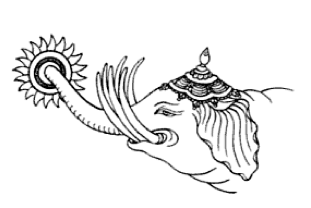
White albino elephants were considered to be the largest out of the species, but this is not the only reason why this particular elephant is significant. The Handbook of Tibetan Buddhist Symbols explains that the white elephant is especially important to the Buddhist story of the dream Queen Maya, Buddha?s mother, experienced. Queen Maya dreamt of a six-tusk white elephant entering her womb at the moment of conception. In the Tibetan this dream is considered to be an indication of the child?s destiny to be Buddha (61). It is also states that it was believed that pearls would form in white elephant?s foreheads. These pearls were noteworthy because they were used to make gorochana, which is a precious medicine that possess different color and potencies that are used to clear poisoning, stimulate clear thoughts, and relieve fevers and infectious diseases (61, 20). Indian religions recognize the elephant?s importance to society, not only due to its physical features, but the animal?s free spirit that can be achieved through meditative practices. All religions that exist throughout India share the belief that elephants stand as a reflective figure, but the animal is an important god figure in Hinduism.
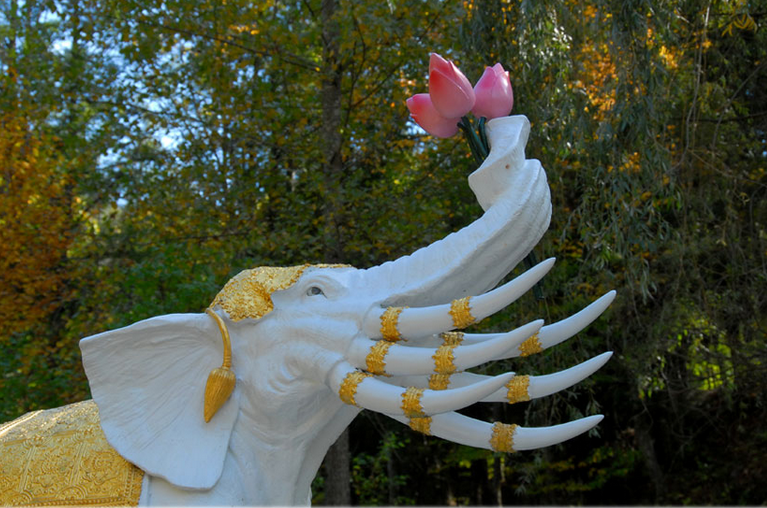
Hinduism is an extremely mystical religion that has impacted the profound spirituality throughout India. One of the most commonly worshipped deities in Hinduism is Ganesha, the elephant-head god with four arms. Prior to becoming this half animal half human creature, Ganesha was the first son of the great god Shiva. In Broken Tusk: Stories of the Hindu God Ganesha, Uma Krishnaswami explains that when his head was decapitated, Shiva replaced it with the head of the first animal he came across, which was an elephant. In The Heart of Hinduism, Stephen Knapp explains, ?Part of the meaning behind this symbolism of the man with an elephant?s head is to represent the unity between the small entity, or man, and the large universe, the elephant? (182?183). This idea, Knapp further explains, comes from the word ?gaja?, which means elephant. ?Ga? meaning the goal and ?ja? meaning the origin, which Knapp expresses that the elephant-headed man represents the man, the origin, who is on the path toward universal consciousness, the goal (183). This idea supports the India?s stress on growing in inner consciousness. The Tibetan explains that the elephant?s ability to use its trunk and tusks to clear jungle paths has developed Ganesha?s reputation as ?the remover of obstacles? (61). Ganesha is worshipped intensely by Hindus because he is the highest god that acts as an example that focusing on the ?dark? in the world can be detrimental to one?s whole being. For example, many Hindu art shows Ganesha holding the taming tools, a noose and a hook. Knapp explains, ?The noose that he holds is to catch delusion, to free one from its affects. The noose also represents attachment that can lead to anger, which hurts us like the goad. The noose or rope is also used to pull his devotees nearer to the Truth and to tie them to the Highest God? (183). This representation of Ganesha coincides with the profound spirituality practiced in India through rituals that are meant to free the mind and soul from negative emotions.

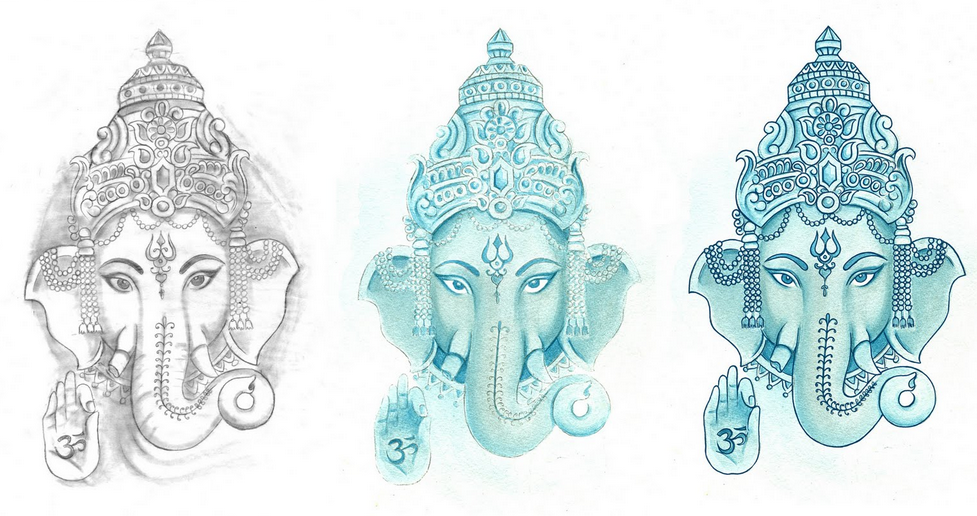
The artistic status of the elephant is not just for its beauty, but also for the powerful, spiritual characteristics and role model status for the people of India. This divine being is shown through paintings and sculptures that are sacred. Elephant art within an environment calls to help individuals carry out the various spiritual rituals that will lead them towards the goal. These are pieces also represent strength, wisdom, overcoming obstacles, and mind purification that the elephant has, which the Indian culture practices toward achieving. After learning this information, I can argue that it is disrespectful for Americans to regard elephant art as being ?hipster? when a huge part of the world creates this art in order to represent the supreme beings of this universe. Elephant art is connected to an extremely spiritual lifestyle that, unlike ?hipsters?, recognizes the divine sources of life. If we want to decorate our atmosphere with art depictions of elephants we must not only understand this information, but also practice these ideas, rituals, and beliefs that are derived from elephants.
Bibliography
?The Handbook of Tibetan Buddhist Symbols.? Google Books. N.p., n.d. Web. 19 Mar. 2015
Welch, Stuart Cary. ?India: Art and Culture 1300?1900.? Google Books. N.p., n.d. Web. 19 Mar. 2015.
Krishnaswam, Uma. ?Broken Tusk: Stories of the Hindu God Ganesha.? Google Books. N.p., n.d. Web. 19 Mar. 2015.
Knapp, Stephen. ?The Heart of Hinduism: The Eastern Path to Freedom, Empowerment, and Illumination.? Google Books. N.p., n.d. Web. 19 Mar. 2015.
Fontana, David. ?The Secret Language of Symbols: A Visual Key to Symbols and Their Meanings.? Google Books. N.p., n.d. Web. 19 Mar. 2015.


